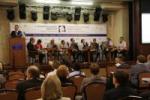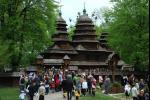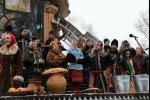- عربي
- Ukraine
- Economy
-
Investment
- Current Investment Trends
- Legal Conditions of Doing Business
- Investment Policy
- Competition
- Setting a Business in Ukraine
- Mergers and Acquisitions
- Taxation
- Import and Export
- Banks and Bank Regulation
- Convertibility and Profits Repatriation
- Currency Regulation
- Protection of Intellectual Property Rights
- Companies
- Travel to Ukraine
- About us
- Useful Sites
- Gallery
- News
Currency rates in UAH
| AED | ||
| BHD | ||
| EGP | ||
| KWD | ||
| LBP | ||
| OMR | ||
| QAR | ||
| SAR | ||
| SYP |
2015-07-06
| Kiev |  |
+32 |
| Donetsk |  |
+28 |
| Dnipropetrovsk |  |
+31 |
| Lviv |  |
+31 |
| Odessa |  |
+27 |
History
Present-day Ukraine originates its history in the seventh century BC when it was ruled by the Scythians. More and more parts of Ukraine have been under the control of foreign powers, and in the third century the area is ruled by the Goths. They were driven out by the Huns in the fourth century. Slavic tribes occupied central and eastern Ukraine in the sixth century and played an important role in the establishment of Kyiv. Situated on lucrative trade routes, Kyiv quickly prospered as the centre of the powerful state of Rus' ('Kyivan Rus'). In the 11th century, Kyivan Rus is, geographically, the largest state in Europe. Kyivan Rus Prince Volodymyr converts the Kyivan nobility and most of the population of Ukraine at that time to Christianity in 988. Conflict among the feudal lords led to decline in the 12th century and many small feudal Russian states are formed. Halytsian-Volynian Principality is the main state in the Ukraine.
In 1239 the history of Ukraine took a dramatic turn East with the Mongols capturing large parts of the area and the country becomes part of Khanate of the Golden Horde (Mongolian State). The northern parts of the area became part of Polandand Lithuania around 1350 and the southern part was ruled by the Tatars since 1430. The latter part became part of the Ottoman Empire. The free (non-Polish or Lithuanian) parts of the country merge into Russia between 1654 and 1667. After the divisions of Poland between 1772 and 1795 all of Ukraine, except for the extreme west (under Austrian rule), was part of Russia. In the nineteenth century Russia bans the use and study of the Ukrainian language.
When World War I and the Russian revolution shattered the Austrian and Russian empires, this epoch marked Ukrainian history with independence of the statehood. In 1917 the Central Rada proclaimed Ukrainian autonomy as the Ukrainian Democratic Republic. In 1918, following the Bolshevik seizure of power in Petrograd, the Ukrainian National Republic declared its independence under President of the parliament, called Central Ukrainian Council, Mykhailo Hrushevsky as the Ukrainian People's Republic. Hrushevsky is the leader of the Ukrainian Socialist Revolutionary Party. The country is occupied by Russia in 1918, followed by a German and Austro-Hungarian occupation later that year. The Ukrainian People's Republic is restored in 1918. From 1919 until 1921 the country is led by Simon Petliura, who was also of the USRP. After three years of conflict and civil war the western part of Ukrainian territory is incorporated into Poland. While the larger, central and eastern regions went under communist rule: the non-Polish parts of Ukraine are later in 1921 absorbed by the Ukrainian Soviet Socialist Republic, and then join the USSR in 1922 as a founding union member. Petliura is assassinated in an exile in 1926.
Stalin’s rise to power and the campaign for collectivization imposed a campaign of terror that ravaged the intellectual class of Ukraine’s population. Stalin also creates an artificial famine (called the Holodomor in Ukrainian language) as part of his forced collectivization policies. The artificial famine killed millions of previously independent peasants and others throughout the country. Estimates of deaths caused by the famine from the 1932-33 range from 3 million to 7 million people.
After the Nazi and Soviet invasions of Poland in 1939, the western Ukrainian regions were incorporated into the USSR. The period between 1941 and 1944 was marked in the history of Ukraine with German occupation. Armed resistance against Soviet authority continues until the 1950s.
1991 was a remarkable year in the Ukrainian history: a referendum on the Act of Declaration of Independence took place on December 1, 1991 where the overwhelming majority of population of Ukraine approved the Act and the state gained its independence. Following free elections held in 1991, Leonid M. Kravchuk, former chairman of the Ukrainian Rada, is elected president for a five-year term. Ethnic tensions in Crimea during 1992 prompt a number of pro-Russian political organizations to advocate secession of Crimea and annexation to Russia. Later that year the Crimean and Ukrainian parliaments determine that Crimea would remain under Ukrainian jurisdiction while retaining significant cultural and economic autonomy.
In 1994, Leonid Kuchma is elected as Ukraine's second president in free and fair elections. Kuchma is re-elected in 1999 to another five-year term with 56 percent of the vote, firstly in Ukraine’s history the second presidential term in a row.
The fraud during Presidential elections in 2004 began what is known as the Orange revolution. The main goal of this revolution was to get freedom of the Ukrainian population’s will and freedom of speech. As a result of the third round of elections, Viktor Yushchenko became the third President in Ukrainian history.
By the time of the presidential election of 2009, Yushchenko and Tymoshenko - allies during the Orange Revolution - had become bitter enemies. As a result of the presidential run-up Yanukovych's pro-Russia party had regained power after five years and the Orange Revolution of 2004 was halted.



